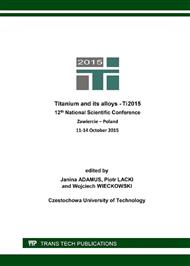p.191
p.199
p.206
p.212
p.220
p.228
p.236
p.243
p.250
Analysis of Heat Transfer through PVC Window Profile Reinforced with Ti6Al4V Alloy
Abstract:
This requires the use of additional reinforcement in order to prevent excessive or permanent deformation of PVC windows. In the paper particular attention was devoted to space located in a corrosive environment exposed to chemical agents. For this purpose, proposed to change the previously used steel profiles reinforcements made of Ti6Al4V titanium alloy corrosion-resistant in the air, at sea and many types of industrial atmosphere. Analysis of the thermal insulation properties of PVC windows with additional reinforcement of profile Ti6Al4V titanium alloy was performed. PVC window set in a layer of thermal insulation was analyzed. Research was conducted using Finite Element Analysis. Numerical models and thermal calculations were made in the program ADINA, assuming appropriate material parameters. The constant internal temperature of 20 ̊ and an outer-20 ̊ was assumed. The course of temperature distribution in baffle in time 24 hours and graphs of characteristic points was obtained. The time of in which followed the steady flow of heat, as well as the course of isotherm of characteristic temperature in the baffle was determined. On the basis of numerical analysis obtained vector distribution of heat flux q [W/m2] and was determined heat transfer coefficients U [W/m2K] for the whole window with titanium reinforcement . All results were compared with the model of PVC windows reinforced with steel profile.
Info:
Periodical:
Pages:
236-242
Citation:
Online since:
April 2016
Authors:
Keywords:
Price:
Сopyright:
© 2016 Trans Tech Publications Ltd. All Rights Reserved
Share:
Citation:


